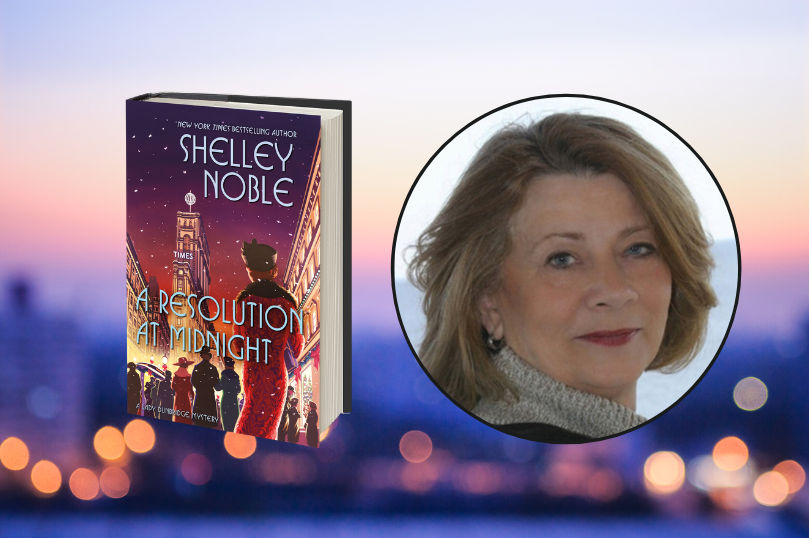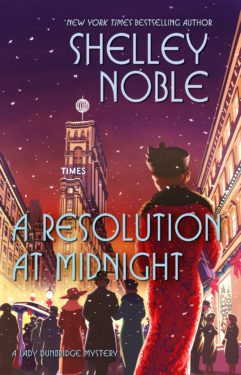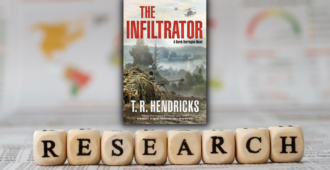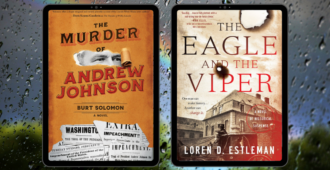A Resolution at Midnight is the most recent installment in the Lady Dunbridge Mysteries by Shelley Noble, and it takes place in Gilded Age Manhattan. Read what it’s like for Shelley to write historical mysteries set in the past while living in the present!
By Shelley Noble
I write historical mysteries; 1900s in Manhattan, the Gilded Age. 1907-8 to be specific. A time of conspicuous consumption and widespread poverty. The era of “the modern woman.” More women are working outside the home, going to college; they still don’t have the vote. Women have lunch in restaurants without male escort—some restaurants. Women who play the stock market, drive automobiles, drink cocktails.
Wives and daughters are still committed to sanitariums to be cured of “hysteria.”
Automobiles are becoming more prevalent on the streets. Telephones grace the homes of the wealthy and businesses. The police department has been reformed by Teddy Roosevelt and has slipped back to its old ways now that he has left for Washington.
Tammany Hall still rules politics. Theater has moved uptown to Broadway. The poor live in crowded tenement buildings on the lower east side. Luxury apartment buildings are springing up on the upper west side. Everyone is saying they are the wave of the future.
The New Years Eve ball will be dropped for the first time in Times Square to welcome in 1908. It’s five feet in diameter, will be lit by 100 electric lights and lowered by pulleys and ropes by five strong men. If it’s a clear night it will be seen all the way to New Jersey.
And as always, change faces great resistance. And from this resistance, stories are made.
Today, walking the same streets, living in the same neighborhoods, going about our own lives, it’s easy to forget the people who went before, who they were, what they wanted, and where their passions led them. There is much about them that is similar to us and much that isn’t, and it’s important not to equate the two when constructing a story.
As writers we all have our quirks, the things that make us unique, drive us crazy, or that we’d like to be able to ignore. Or the worst (for me) wanting to tell it all. So I made myself a little crib sheet. To remind me how to stay on track.
NOTE TO SELF: How to Write the Past While Living in the Present.
- Every Era is the modern era to the people living in it. Don’t look down or back on your characters. They are the culmination of history thus far. Their stories are current events. Breaking news.
- Take yourself down the rabbit hole.
Immerse yourself in real history. Like Alice, you may find yourself in uncharted territory – for you anyway. But somebody charted it before you. Embrace it. Live it, don’t be afraid to stay there. You won’t get lost. Not for long anyway. You have a deadline. You’ll get it done. (Note to others: If you don’t have a deadline, give yourself one. There is definitely addictive temptation in research.)Research matters a lot – it’s really important. But only when it affects your characters. The description you depict is the description they live. What they see. Not what you’ve learned. You’re just the fly on the wall. No, not a fly. You’re an eager paid assistant. Pay attention. Don’t talk, don’t opine, don’t suggest. Just do the work.
- Location, location, location If you can walk it like a local, see it like a tourist, listen like a history whisperer, your setting will come alive. Setting is interactive. Make it breathe with your characters. There is no setting outside the people using it, living in it, experiencing it, sometimes being destroyed by it.
- From the horse’s mouth…
Use primary sources. The New York Times archive reaches back 150 years. Plenty of stuff there, plenty of reporters out getting the news, risking their lives for the story. Memoirs, diaries, letters… but remember a person’s need to protect their own secrets. The written word is not always the truth. Crawl into your characters until you understand them, feel their feelings, speak their language, because they are the modern people of their history. Make sure they aren’t speaking your language. Check your dates on dialogue. - …And the eyes of the beholder. See what the characters see or choose not to see or what they might see if they paid more attention. You are not the arbiter. You don’t get to tell the present about the past, they do. It’s their job. Let them be who they want to be. Trust them. They won’t act out of period (if you’ve done your research). They live there.
- Clap your hands to the music. Life was different then, the speed, the way of doing things. Living had a different rhythm, different priorities. Don’t be impatient, this is their story, give them time (even though it would be a lot simpler if they had cell phones).
- Stuff matters.
Get it right. Most people won’t notice little mistakes, but the people you create will, and you have to live with them, maybe forever. (That one sometimes keeps me up at night.)
- It’s not always what you think. Actually it’s hardly ever what you think. There are misconceptions about every age. Preconceptions abound for every era, you don’t have to further them. Some readers will complain because you question what they’ve heard. Be brave. Don’t let indecision thwart your story. Take responsibility. (And clarify things in the Author’s Notes. That’s what they’re for. Fifth Avenue was not always one way south.)
- Decide what’s important Be prepared to change your mind. It’s hard to throw out days or weeks of research. Especially if it’s fascinating. It’s still there even if you don’t use it on the page. It might be the skeleton, the foundation you don’t see. It’s still a part of the world you recreated. And it is important.
- Yeah it matters.
When you think about skimping, don’t. Take the space the story needs, not a word more or less. Repeat this aloud ten times. Then do it right.
And sometimes, surprisingly, I do.
Grab a Copy of A Resolution at Midnight—on sale now!












